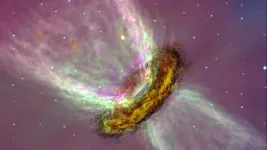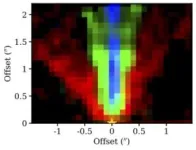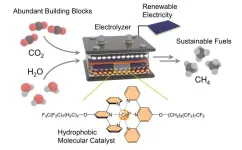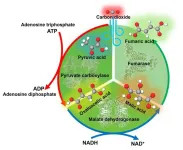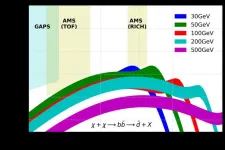(Press-News.org) Every second, more than 3,000 stars are born in the visible universe. Many are surrounded by what astronomers call a protoplanetary disk – a swirling "pancake" of hot gas and dust from which planets form. The exact processes that give rise to stars and planetary systems, however, are still poorly understood.
A team of astronomers led by University of Arizona researchers has used NASA's James Webb Space Telescope to obtain some of the most detailed insights into the forces that shape protoplanetary disks. The observations offer glimpses into what our solar system may have looked like 4.6 billion years ago.
Specifically, the team was able to trace so-called disk winds in unprecedented detail. These winds are streams of gas blowing from the planet-forming disk out into space. Powered largely by magnetic fields, these winds can travel tens of miles in just one second. The researchers' findings, published in Nature Astronomy, help astronomers better understand how young planetary systems form and evolve.
According to the paper's lead author, Ilaria Pascucci, a professor at the U of A's Lunar and Planetary Laboratory, one of the most important processes at work in a protoplanetary disk is the star eating matter from its surrounding disk, which is known as accretion.
"How a star accretes mass has a big influence on how the surrounding disk evolves over time, including the way planets form later on," Pascucci said. "The specific ways in which this happens have not been understood, but we think that winds driven by magnetic fields across most of the disk surface could play a very important role."
Young stars grow by pulling in gas from the disk that's swirling around them, but in order for that to happen, gas must first shed some of its inertia. Otherwise, the gas would consistently orbit the star and never fall onto it. Astrophysicists call this process "losing angular momentum," but how exactly that happens has proved elusive.
To better understand how angular momentum works in a protoplanetary disk, it helps to picture a figure skater on the ice: Tucking her arms alongside her body will make her spin faster, while stretching them out will slow down her rotation. Because her mass doesn't change, the angular momentum remains the same.
For accretion to occur, gas across the disk has to shed angular momentum, but astrophysicists have a hard time agreeing on how exactly this happens. In recent years, disk winds have emerged as important players funneling away some gas from the disk surface – and with it, angular momentum – which allows the leftover gas to move inward and ultimately fall onto the star.
Because there are other processes at work that shape protoplanetary disks, it is critical to be able to distinguish between the different phenomena, according to the paper's second author, Tracy Beck at NASA's Space Telescope Science Institute.
While material at the inner edge of the disk is pushed out by the star's magnetic field in what is known as X-wind, the outer parts of the disk are eroded by intense starlight, resulting in so-called thermal winds, which blow at much slower velocities.
"To distinguish between the magnetic field-driven wind, the thermal wind and X-wind, we really needed the high sensitivity and resolution of JWST (the James Webb Space Telescope)," Beck said.
Unlike the narrowly focused X-wind, the winds observed in the present study originate from a broader region that would include the inner, rocky planets of our solar system – roughly between Earth and Mars. These winds also extend farther above the disk than thermal winds, reaching distances hundreds of times the distance between Earth and the sun.
"Our observations strongly suggest that we have obtained the first images of the winds that can remove angular momentum and solve the longstanding problem of how stars and planetary systems form," Pascucci said.
For their study, the researchers selected four protoplanetary disk systems, all of which appear edge-on when viewed from Earth.
"Their orientation allowed the dust and gas in the disk to act as a mask, blocking some of the bright central star's light, which otherwise would have overwhelmed the winds," said Naman Bajaj, a graduate student at the Lunar and Planetary Laboratory who contributed to the study.
By tuning JWST's detectors to distinct molecules in certain states of transition, the team was able to trace various layers of the winds. The observations revealed an intricate, three-dimensional structure of a central jet, nested inside a cone-shaped envelope of winds originating at progressively larger disk distances, similar to the layered structure of an onion. An important new finding, according to the researchers, was the consistent detection of a pronounced central hole inside the cones, formed by molecular winds in each of the four disks.
Next, Pascucci's team hopes to expand these observations to more protoplanetary disks, to get a better sense of how common the observed disk wind structures are in the universe and how they evolve over time.
"We believe they could be common, but with four objects, it's a bit difficult to say," Pascucci said. "We want to get a larger sample with James Webb, and then also see if we can detect changes in these winds as stars assemble and planets form."
For a complete list of authors, please see the paper, "The nested morphology of disk winds from young stars revealed by JWST/NIRSpec observations," Nature Astronomy (DOI 10.1038/s41550-024-02385-7). Funding for this work was provided by NASA and the European Research Council.
END
Winds of change: James Webb Space Telescope reveals elusive details in young star systems
Astronomers have discovered new details of gas flows that sculpt planet-forming disks and shape them over time, offering a glimpse into how our own solar system likely came to be.
2024-10-04
ELSE PRESS RELEASES FROM THIS DATE:
UC Merced co-leads initiative to combat promotion and tenure bias against Black and Hispanic faculty
2024-10-04
Black and Hispanic faculty members seeking promotion at research universities face career-damaging biases, with their scholarly production judged more harshly than that of their peers, according to a groundbreaking initiative co-led by the University of California, Merced that aims to uncover the roots of these biases and develop strategies for change.
Junior professors are generally evaluated and voted on for promotion and tenure by committees comprising senior colleagues. In one of the studies conducted by the research team, results suggest that faculty from underrepresented minorities received 7% more negative votes from ...
Addressing climate change and inequality: A win-win policy solution
2024-10-04
Climate change and economic inequality are deeply interconnected, with the potential to exacerbate each other if left unchecked. A new study published in Nature Climate Change sheds light on this critical relationship using data from eight large-scale Integrated Assessment Models (IAMs) to examine the distributional impacts of climate policies and climate risks. The study provides robust evidence that climate policies aligned with the Paris Agreement can mitigate long-term inequality while addressing climate change.
Led by Johannes Emmerling, Senior Scientist at the Euro-Mediterranean ...
Innovative catalyst produces methane using electricity
2024-10-04
Researchers at the University of Bonn and University of Montreal have developed a new type of catalyst and used it in their study to produce methane out of carbon dioxide and water in a highly efficient way using electricity. Methane can be used, for example, to heat apartments or as a starting material in the chemical industry. It is also the main component of natural gas. If it is produced using green electricity, however, it is largely climate neutral. The insights gained from the model system studied by the researchers can be transferred to large-scale technical ...
Liver X receptor beta: a new frontier in treating depression and anxiety
2024-10-04
Houston, Texas – In a state-of-the-art Bench to Bedside review published in the journal Brain Medicine (Genomic Press), researchers Dr. Xiaoyu Song and Professor Jan-Åke Gustafsson from the University of Houston and Karolinska Institutet (Sweden) shed light on the therapeutic potential of liver X receptor beta (LXRβ) in treating depression and anxiety. This comprehensive analysis marks a significant step forward in understanding the molecular underpinnings of mental health disorders and potentially revolutionizing their treatment.
LXRβ, a nuclear receptor initially known for its role in cholesterol metabolism and inflammation, is now emerging as a crucial ...
Improving fumaric acid production efficiency through a ‘more haste, less speed’ strategy
2024-10-04
As plastic waste continues to build up faster than it can decompose, the need for biodegradable solutions is evident.
Previously, Professor Yutaka Amao and his team at Osaka Metropolitan University’s Research Center for Artificial Photosynthesis succeeded in synthesizing fumaric acid, a raw material for biodegradable plastics from biomass-derived pyruvic acid and carbon dioxide. However, the fumaric acid production process reported earlier has a problem with producing undesirable substances as byproducts in addition to L-malic acid, which is ...
How future heatwaves at sea could devastate UK marine ecosystems and fisheries
2024-10-04
The oceans are warming at an alarming rate. 2023 shattered records across the world’s oceans, and was the first time that ocean temperatures exceeded 1oC over pre-industrial levels. This led to the emergence of a series of marine heatwave events across both hemispheres, from the waters around Japan, around South America, and across the wider North Atlantic. Marine heatwaves are periods of extremely warm sea temperatures that can form in quite localized hot spots but also span large parts of ocean ...
Glimmers of antimatter to explain the "dark" part of the universe
2024-10-04
One of the great challenges of modern cosmology is to reveal the nature of dark matter. We know it exists (it constitutes over 85% of the matter in the Universe), but we have never seen it directly and still do not know what it is. A new study published in JCAP has examined traces of antimatter in the cosmos that could reveal a new class of never-before-observed particles, called WIMP (Weakly Interacting Massive Particles), which could make up dark matter. The study suggests that some recent observations ...
Kids miss out on learning to swim during pandemic, widening racial and ethnic disparities
2024-10-04
Nearly three out of four kids in Chicago had no swimming lessons in summer of 2022, with significant racial and ethnic differences, according to a parent survey from Ann & Robert H. Lurie Children’s Hospital of Chicago published in Pediatrics. Black and Hispanic/Latine kids were disproportionately affected (85 percent and 82 percent, respectively), compared to white kids (64 percent).
The most common reasons for not getting swimming lessons also differed among racial and ethnic groups. Parents of White kids reported they ...
DGIST restores the performance of quantum dot solar cells as if “flattening crumpled paper!”
2024-10-04
□ Professor Jongmin Choi’s team from the Department of Energy Science and Engineering at DGIST (President Kunwoo Lee) conducted joint research with Materials Engineering and Convergence Technology Professor Tae Kyung Lee from Gyeongsang National University and Applied Chemistry Professor Younghoon Kim from Kookmin University. The researchers developed a new method to improve both the performance and the stability of solar cells using “perovskite quantum dots.” They developed longer-lasting solar cells by addressing the issue of distortions on the surface of quantum dots, which deteriorate the ...
Hoarding disorder: ‘sensory CBT’ treatment strategy shows promise
2024-10-04
Rehearsing alternative outcomes of discarding through imagery rescripting shows promise as a treatment strategy for people who hoard, a study by UNSW psychology researchers has shown.
Hoarding disorder is a highly debilitating condition that worsens with age. People who hoard form intense emotional attachments to objects, accumulate excessive clutter, and have difficulty discarding possessions. Many avoid treatment.
People who hoard also experience more frequent, intrusive and distressing mental images in their daily lives, says Mr Isaac Sabel from the Grisham Research Lab, an experimental clinical psychology research group at UNSW Sydney.
“Negative ...
LAST 30 PRESS RELEASES:
Weaving secondary battery electrodes with fibers and tying them like ropes for both durability and performance
Using social media may impair children’s attention
Science briefing: An update on GLP-1 drugs for obesity
Lower doses of immunotherapy for skin cancer give better results
Why didn’t the senior citizen cross the road? Slower crossings may help people with reduced mobility
ASH 2025: Study suggests that a virtual program focusing on diet and exercise can help reduce side effects of lymphoma treatment
A sound defense: Noisy pupae puff away potential predators
Azacitidine–venetoclax combination outperforms standard care in acute myeloid leukemia patients eligible for intensive chemotherapy
Adding epcoritamab to standard second-line therapy improves follicular lymphoma outcomes
New findings support a chemo-free approach for treating Ph+ ALL
Non-covalent btki pirtobrutinib shows promise as frontline therapy for CLL/SLL
University of Cincinnati experts present research at annual hematology event
ASH 2025: Antibody therapy eradicates traces of multiple myeloma in preliminary trial
ASH 2025: AI uncovers how DNA architecture failures trigger blood cancer
ASH 2025: New study shows that patients can safely receive stem cell transplants from mismatched, unrelated donors
Protective regimen allows successful stem cell transplant even without close genetic match between donor and recipient
Continuous and fixed-duration treatments result in similar outcomes for CLL
Measurable residual disease shows strong potential as an early indicator of survival in patients with acute myeloid leukemia
Chemotherapy and radiation are comparable as pre-transplant conditioning for patients with b-acute lymphoblastic leukemia who have no measurable residual disease
Roughly one-third of families with children being treated for leukemia struggle to pay living expenses
Quality improvement project results in increased screening and treatment for iron deficiency in pregnancy
IV iron improves survival, increases hemoglobin in hospitalized patients with iron-deficiency anemia and an acute infection
Black patients with acute myeloid leukemia are younger at diagnosis and experience poorer survival outcomes than White patients
Emergency departments fall short on delivering timely treatment for sickle cell pain
Study shows no clear evidence of harm from hydroxyurea use during pregnancy
Long-term outlook is positive for most after hematopoietic cell transplant for sickle cell disease
Study offers real-world data on commercial implementation of gene therapies for sickle cell disease and beta thalassemia
Early results suggest exa-cel gene therapy works well in children
NTIDE: Disability employment holds steady after data hiatus
Social lives of viruses affect antiviral resistance
[Press-News.org] Winds of change: James Webb Space Telescope reveals elusive details in young star systemsAstronomers have discovered new details of gas flows that sculpt planet-forming disks and shape them over time, offering a glimpse into how our own solar system likely came to be.
